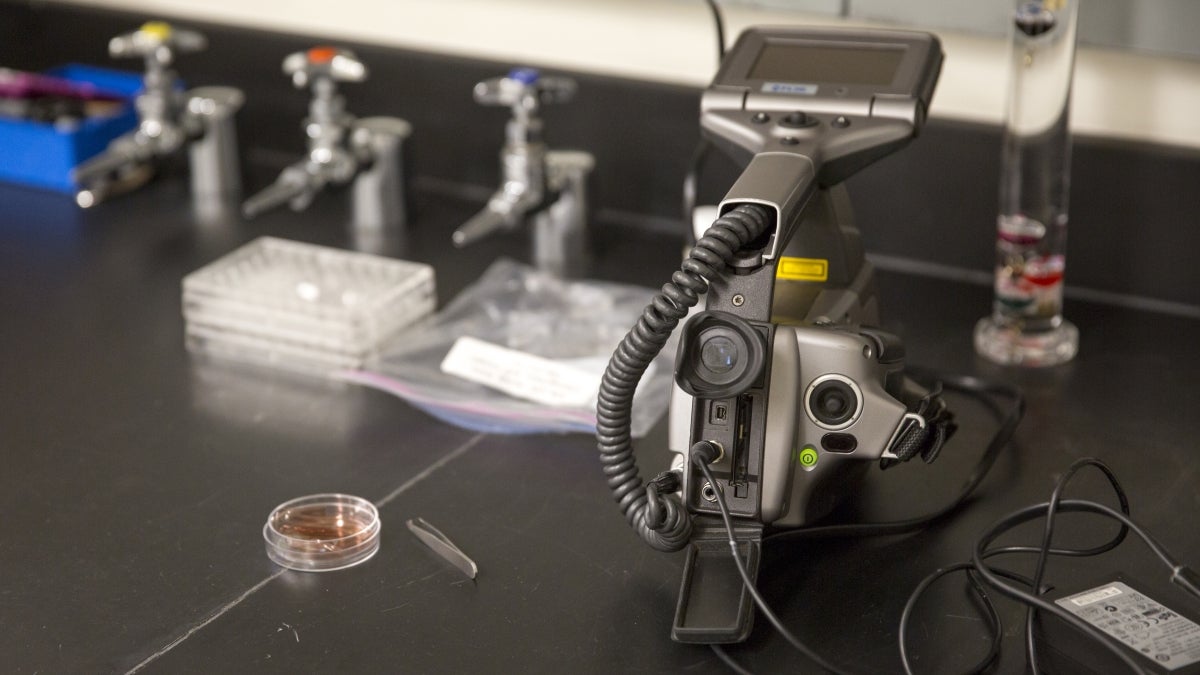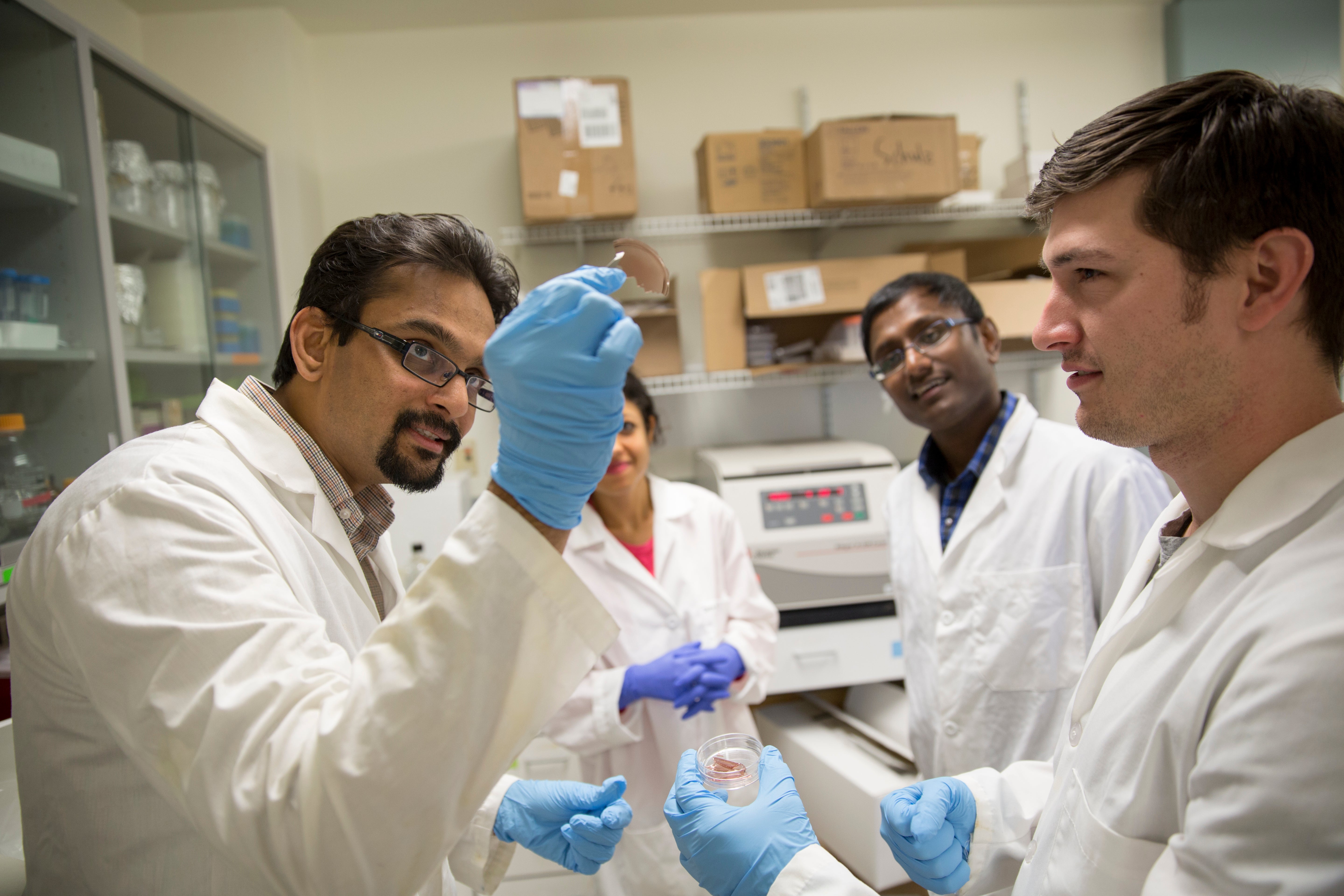In the age of nanotechnology, medical advances are increasingly a matter of finding the right combinations of materials to help perform specific therapeutic or restorative functions.
Used at the nanoscale — the typical thickness of a single human hair is about 100,000 nanometers wide — common materials take on characteristics and abilities that they don’t exhibit in bulk quantities.
Gold, for instance, is an effective photothermal converter at the nanoscale, meaning it’s good for converting light into heat.
Kaushal Rege, an associate professor of chemical engineering in the Ira A. Fulton Schools of Engineering at Arizona State University, has been using gold nanorods as a key ingredient in a new kind of body-tissue sealant.
Using near-infrared laser light to heat a nanocomposite of gold nanorods embedded in a matrix of polypeptides (chains of amino acids that can fuse with ruptured tissues), Rege’s laboratory team can process the mixture of materials into a “nanosolder” for sealing tissues separated by rupture or surgical incisions.
The technique could, in many cases, improve on or at least supplement conventional stitches and sutures used in tissue repair.
Collaborations with medical experts
Rege’s progress has brought support from the National Institutes of Health (NIH), most recently an R01 grant to provide $1.6 million over three and a half years to expand his research and development in this area.
RO1 grants support health-related research and development that helps to fulfill the central mission of the NIH to seek and apply new knowledge that can enhance health, lengthen life and reduce illness and disability.
The work was initially seeded by funds from the Mayo Center for Regenerative Medicine in collaboration with Dr. Tonia Young-Fadok, a colorectal surgeon at the Mayo Clinic in Phoenix.
Rege will lead a team of collaborators from ASU; the College of Veterinary Medicine at Midwestern University in Glendale, Arizona; and the Mayo Clinic College of Medicine in Phoenix in efforts to improve on such nanobiomaterial sealants.
“You could envision this being done to aid ocular and microvascular surgeries or even nerve repair."
— Kaushal Rege, associate professor of chemical engineering
They will concentrate on ways to make the welded seals leak-proof. Leaks in sutures and common sealants, particularly in delicate tissues like those of intestines, can cause bacterial infections that are sometimes life-threatening.
Rege’s team will strive to create nanocomposites with mechanical properties — such as tensile strength and burst pressures — that will enable sealants to maintain elasticity while at the same time withstanding the levels of pressure from body fluids that can causes other sealants to leak or burst.
Arizona State University chemical engineer Kaushal Rege (left) is giving graduate students the opportunity to help develop a technique that uses lasers to seal body tissue that has been separated by surgical incisions or torn by injury. Photos by Nora Skrodenis/ASU
Researchers will focus on one of the more delicate kinds of tissues, those of the colorectal system.
“These are tissues with some of the highest susceptibility to leakage due the wear and tear around the sites of surgical incisions and suturing,” Rege said. “I think we can make some engineering contributions to preventing this by coming up with stronger nanocomposite solders that hold up even on the more fragile tissues.”
Expanded uses of welding technique envisioned
Researchers are exploring the use of laser welding to fuse tissues that make up the liver, urinary tract, nerves, skin, cartilage, corneas and blood vessels. Providing a more effective liquid-tight but elastic weld for those tissues could enhance treatment of diseases and maladies that afflict tens of millions of people throughout the world.
Beyond use for welding of tissues to close surgical incisions and repair injury, Rege said it could be possible to use laser-welding techniques to attach small implantable medical devices containing protective or curative mixtures of nanobiomaterials to certain types of tissues inside the body.
“You could envision this being done to aid ocular and microvascular surgeries or even nerve repair. But this is still very new technology, so ideas about these applications are speculative,” he said.
Rege, who is also on the faculties of the graduate studies programs in biomedical engineering, materials science and engineering, and biological design, is directing a multidisciplinary team for the project titled Photothermal Nanocomposites for Tissue Repair. The team includes:
• Dr. Michael Jaffe, an assistant professor of veterinary medicine and surgeon on the faculty of Midwestern University
• Dr. Valerie Wong, an assistant professor of veterinary medicine and pathologist on the faculty of Midwestern University
• Garrick Wallstrom, an assistant professor in the Department of Biomedical Informatics in ASU’s College of Health Solutions, and faculty member in the Center for Personalized Diagnostics in the Biodesign Institute at ASU
• Sarah Stabenfeldt, an assistant professor of biomedical engineering in the School of Biological and Health Systems Engineering at ASU.
• Dr. Tonia M. Young-Fadok, a professor of surgery at Mayo Clinic College of Medicine and chair of the Division of Colon and Rectal Surgery at Mayo Clinic in Phoenix
ASU chemical engineering graduate students Russell Urie and Huang-Chaio Huang and undergraduate students Sana Quraishi, Alisha Nanda, Jerry Crum and Tanner Flake have contributed to early research in this area.
More Science and technology

Ancient sea creatures offer fresh insights into cancer
Sponges are among the oldest animals on Earth, dating back at least 600 million years. Comprising thousands of species, some with lifespans of up to 10,000 years, they are a biological enigma.…

When is a tomato more than a tomato? Crow guides class to a wider view of technology
How is a tomato a type of technology?Arizona State University President Michael Crow stood in front of a classroom full of students, holding up a tomato.“This object does not exist in nature,” he…

Student exploring how AI can assist people with vision loss
Partial vision loss can make life challenging for more than 6 million Americans. People with visual disabilities that can’t be remedied with glasses or contacts can sometimes struggle to safely…

